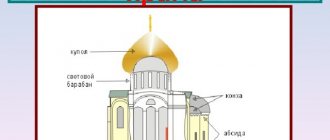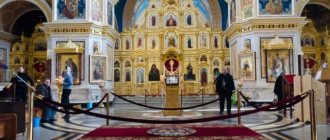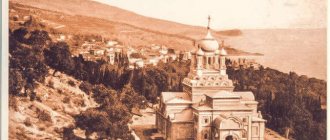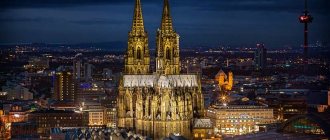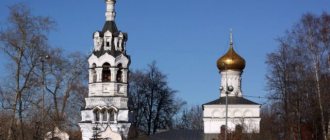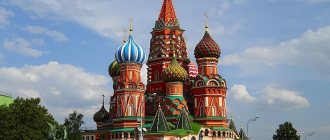Ancient Christian Byzantium became the founder of the construction of cross-domed churches, from where this architectural system began to spread throughout the world. In Rus' it became fundamental. This is how Russian stone architecture appeared, which actively developed until the 16th century. Later, pillarless temples began to be built en masse in Russia.
The cross-dome system is based on a rectangular volume that is formed by the walls of the temple. The interior of the building is equipped with four free-standing pillars. They hold the light drum and dome. The square in the center is surrounded by four rectangular ends (each of them directed towards a certain direction), above which there are barrel vaults. The eastern end is completed by a semicircular apse with an altar. To cover corner rooms, vaults of different shapes are used.
Internal organization
Christian churches are the heirs of Old Testament buildings. Sacred buildings of the Abrahamic religious faith, in particular the Orthodox, are still built today taking into account a three-part scheme, the basis of which was the tabernacle - the Temple of Solomon and the repository of the Covenant, made by Moses at God's command.
The structure stretches from the entrance to the altar, from west to east . The meaning of this composition is that it indicates the path that a person must take in order to reunite with the Lord. The first cell, the porch (in Western countries - narthex), denotes a world that has not yet been renewed, which is in sin.
During the service in this room there are believers who have been excluded from communion and catechumens - those preparing for baptism. Then there is the main volume, the nave, symbolizing the sanctuary of the tabernacle and Noah's ark. This is the place where baptized Christians receive salvation after communion.
At the end there is the main part of the temple, where access is limited for many believers - the altar with a throne. Here the main event of the service begins: wine and bread turn into the blood and body of the Savior.
External appearance
The temple was built from several elements. From the east, the main structure is connected to the altar room. From the outside, these are semicircular buildings - apses, of which there can be one, three or five. At the top, above the main volume, there are one or two drums - these are multifaceted or rounded towers with windows, through which the room is illuminated inside. The drums end in a spherical dome, but it is not visible from the outside; only the heads can be observed.
The heads come in two forms : bulbous and helmet-shaped. Unlike the dome, which is the most important element of the entire structure, they do not bear any structural load: they are a decorative frame that protects the ceiling from precipitation.
The entrance can be arranged from the porch, the platform near the temple, or through various extensions - a walkway, a porch. To prevent Christians from crowding, refectories were added to the main building.
In addition, the structure may include belfries and bell towers.
Iconostasis design
The iconostasis resembles a screen that demonstrates divine life to Christians - it arose in the cross-domed churches of Ancient Rus' relatively late, in the 15th century. Before this, small colonnades or low altar barriers in the form of balustrades were used.
The iconostasis has several tiers. If considered from top to bottom, they are ordered taking into account the events that occurred in sacred history:
- The forefathers' (top) row is dedicated to those who lived before the first Law of God, which was told to Moses (Adam, Eve, Noah, Abraham, Cain, Abel).
- Below is a description of those who lived during the Old Testament, that is, from Moses to Jesus (Daniel, Solomon, David).
- The next tier is festive. The symbolism tells about the life of Jesus on earth and is displayed in liturgical history (holidays that are dedicated to the main events of the Savior: Presentation, Epiphany, Christmas).
- The most important tier is the one where the Deesis is located. John the Baptist and the Most Holy Theotokos stand next to Christ in prayer for people, behind them are the great martyrs and apostles.
- The lower tier is local. Here are the faces of the Mother of God and Jesus, as well as images of local revered clergy and the icon in whose name the temple was created.
A special passage in the middle of the iconostasis, the double-leaf Royal Gate, symbolizes the entrance to heaven.
St. Sophia Cathedral and other temples
Separately, it is worth mentioning the St. Sophia Cathedral of Constantinople, built in the first half of the 6th century by combining the plan of a basilica and a dome over a huge internal space. The middle nave is covered with a central dome. The main structure is supported by semi-domes, so it is distinguished by its longitudinal orientation. Two-tier arcades separate the main space from the choir and side naves. The top side walls with windows are equipped with lunettes. Between these structures, a cross call is formed, but without a cross.
Around the same time, the construction of the Church of St. Irene in Constantinople was completed, which at first was similar in structure to St. Sophia Cathedral, but with choirs on the side naves. In the 8th century, the temple was reconstructed and its interior changed, and the church itself became cross-domed. The builders dismantled the arcades on the second tiers. The dome of the temple was supported by arches that were connected to the side vaults in the shape of cylinders. The new composition resulted in a cross, each side of which was completed by four expanding vaults. Such temples were built later. The Asia Minor church in Dere-Azgy, built in the 9th century, has a lower tier with three naves, and the dome space is equipped with side arcades.
Choose an answer
Paintings and mosaics
The horizontal axis of the church denotes the spiritual path of the righteous, and the vertical axis reflects the sacred structure of the world. The face of Christ Pantocrator is installed on top of the dome of the main drum. Since the 17th century, another iconography has been used - “Fatherland”: with the Holy Spirit, God, Son of God.
Next are the apostles and prophets. The evangelists were depicted on the four sails, and the pillars of the Church on the supports: the venerables, saints and great martyrs. The main sacred historical events are depicted on the walls. On the western side, that is, on the wall where the exit is located, there are paintings of the Last Judgment, which are a reminder for parishioners leaving the church. The apse of the altar is dedicated to the bright stories of Christian teaching - the sacrament of the Eucharist.
Construction in Ancient Rus'
The first builders were the Byzantines and residents from countries that were under the rule of Constantinople.
In Byzantium, by the end of the millennium, a certain system for constructing Orthodox church structures had already developed, which is still considered the main one in East Slavic countries.
These temples belonged to an even later type of building - basilicas. It was the basilica - a long room used for judicial proceedings, in which the judge's chair was located on a round apse extension - that was taken as a model for Christian churches of the first centuries.
After baptism, Ancient Russia had its own craftsmen , and almost immediately the appearance of the temples began to differ from Byzantine buildings. The composition became holistic: all parts of Byzantine churches were arranged separately, while the elements of ancient Russian churches were inseparable from the overall structure.
By the 12th century, each region had its own builders, and the designs in different principalities of Rus' received certain stylistic differences. At the same time, European workers also worked in Rus'. In such cases, the design of the temples remained Eastern Christian, but in the decorative painting of the facades one can notice features of the then prevailing Romanesque style.
Builders from Constantinople taught Russian craftsmen to make a special brick - plinth , which was known back in Rome. These are relatively thin ceramic tiles that are easy to dry and fire. In the 12th century, another technology came from Europe. The outer surfaces of the walls were lined with well-hewn limestone, and the seams were sealed with mortar and small stones.
The main building material in Rus' has always been wood, and wooden structures had a significant influence on the style of stone churches.
For example, an octagon on a quadruple and tent floors.
Stone tented churches
The forms of wooden temples influenced stone (brick) construction.
They began to build intricate stone tented churches that resembled huge towers (pillars). The highest achievement of stone hipped architecture is rightfully considered the Intercession Cathedral in Moscow, better known as St. Basil's Cathedral, a complex, intricate, multi-decorated structure of the 16th century.
The basic plan of the cathedral is cruciform. The cross consists of four main churches located around the middle one, the fifth. The middle church is square, the four side ones are octagonal. The cathedral has nine temples in the form of cone-shaped pillars, together making up one huge colorful tent.
Tents in Russian architecture did not last long: in the middle of the 17th century. Church authorities prohibited the construction of tented churches, since they were sharply different from the traditional one-domed and five-domed rectangular (ship) churches.
Tent architecture of the 16th-17th centuries, which draws its origins from traditional Russian wooden architecture, is a unique direction of Russian architecture, which has no analogues in the art of other countries and peoples.
Stone tented Church of the Resurrection of Christ in the village of Gorodnya.
St Basil's Church
Church of the Intercession in Fili. The first stone tented temple
Temple "Quench My Sorrows" Saratov
Church of the Ascension in Kolomenskoye
Stone tented Church of the Resurrection of Christ in the village of Gorodnya.
St Basil's Church
Church of the Intercession in Fili. The first stone tented temple
Temple "Quench My Sorrows" Saratov
Church of the Ascension in Kolomenskoye
Changes after the Mongols
Cross-domed churches predominated in temple construction in Rus'. The layouts and designs in large buildings are still used today. But in small churches, pillarless structures are usually used, that is, the vaults rest directly on the walls, and not on the columns in the room.
These structures were also built in the pre-Mongol period, but in the 16th–17th centuries many more of them appeared. One of these solutions was hipped ceilings, which gave the Christian church a pro-Western look. In the 60s In the 17th century, Patriarch Nikon banned these structures as not consistent with Orthodox traditions.
To increase the space, refectories began to be added to the temples . If in monasteries this was the name for special rooms for eating food with small built-in churches, then in this case, on the contrary, an additional extension was added to the church, in which no one ate food, but the name did not change.
Basilica with dome
The cross-domed system was primarily created by changing the appearance of the basilica while essentially preserving its structure. In the 4th century, the construction of the Temple of the Apostles in the form of basilicas connected in the shape of a cross was completed in Constantinople. This religious building served as a model for the subsequent construction of many European buildings of the 6th century, for example, the Ephesian Temple of John the Evangelist, whose western part was extended. Inside, it consisted of square cells, and six domes rose above them. Ancient architects tried to combine the basilica with a dome from the 5th century. Similar transitional structures can be called:
- basilica in the Greek city of Philippi;
- temple in Martiropol (modern Silvan, Türkiye);
- several Egyptian monastic churches.
The construction of the temple in the Alahan monastery was completed in the 5th century. This is a three-nave basilica, which is covered by a wooden dome in the form of a pyramid. In the western part of the building there were dividing stone pillars, and arcades on small columns separated the sides from the dome of the eastern room. Similar original designs formed a lateral movement inside the temples, after which the cross under the dome was formed. In the 6th century, mass construction of such structures began.
Centric structures
Centric temples were built according to the canons of Roman architecture, which achieved great perfection in the creation of domed buildings (palace halls, mausoleums). The great domed structure in Rome was the Pantheon. In the eastern part of the Byzantine Empire, in which the process of creating centric cathedrals took place most actively, the architecture of Christianity was based on the structures of pagan sanctuaries, for example, the hexagonal square in the temple of Baalbek.
The centric cathedrals of Palestine of the 4th century, built under Constantine, were ordinary octagons (octagons) or rotundas without extensions. Over time, the temples had an apse; its function initially did not always coincide with the altar. Here they could begin a prayer service with the reading of the Gospel, and the Eucharist took place in the middle of the church under the dome. Gradually, the rotundas were supplemented with various rooms, for example, rooms for pilgrims.
Around the 6th century, a type of octagon was formed, where the corner parts were connected to round niches, completing the corners of the square. This type included the Church of St. George in Ezra (516) and the tomb temple in Rusafa (at the grave of the Great Martyr Sergius). The Cathedral in Bosra (513) was a square with an inscribed circle. The center of the circular rotunda was in the shape of a quadrifolium. So the middle part took the form of a quatrefoil cross, ending with a dome. The size of such structures was so huge that it was usually impossible to cover them with a stone dome. The roof was made of wood.
Types of Orthodox churches
Temples in the Orthodox Church were built of several types , but each temple symbolically corresponded to church doctrine.
1. Temples in the form of a cross were built as a sign that the Cross of Christ is the foundation of the Church, through the Cross humanity was delivered from the power of the devil, through the Cross the entrance to Paradise, lost by our ancestors, was opened.
2. Temples in the shape of a circle (a circle that has neither beginning nor end, symbolizes eternity) speaks of the infinity of the existence of the Church, its indestructibility in the world according to the word of Christ
3. Temples in the shape of an eight-pointed star symbolize the Star of Bethlehem, which led the Magi to the place where Christ was born. Thus, the Church of God testifies to its role as a guide to the life of the Future Age. The period of the earthly history of mankind was counted in seven large periods - centuries, and the eighth is eternity in the Kingdom of God, the life of the next century.
4. Temple in the shape of a ship . Temples in the shape of a ship are the most ancient type of temples, figuratively expressing the idea that the Church, like a ship, saves believers from the disastrous waves of everyday sailing and leads them to the Kingdom of God.
5. Temples of mixed types : cruciform in appearance, but round inside, in the center of the cross, or rectangular in outer shape, and round inside, in the middle part.
Cross type. Church of the Ascension outside the Serpukhov Gate. Moscow
Diagram of a temple built in the shape of a cross
Cross type. Church of Barbara on Varvarka. Moscow.
Cross shape. Church of St. Nicholas the Wonderworker
Rotunda. Smolensk Church of the Trinity-Sergius Lavra
Diagram of a temple in the shape of a circle
Rotunda. Church of Metropolitan Peter of the Vysoko-Petrovsky Monastery
Rotunda. Church of All Who Sorrow Joy on Ordynka. Moscow
Diagrams of a temple in the shape of an eight-pointed star
Ship type. Church of St. Dmitry on Spilled Blood in Uglich
Diagram of the temple in the form of a ship
Ship type. Church of the Life-Giving Trinity on Sparrow Hills. Moscow
Cross type. Church of the Ascension outside the Serpukhov Gate. Moscow
Diagram of a temple built in the shape of a cross
Cross type. Church of Barbara on Varvarka. Moscow.
Cross shape. Church of St. Nicholas the Wonderworker
Rotunda. Smolensk Church of the Trinity-Sergius Lavra
Diagram of a temple in the shape of a circle
Rotunda. Church of Metropolitan Peter of the Vysoko-Petrovsky Monastery
Rotunda. Church of All Who Sorrow Joy on Ordynka. Moscow
Diagrams of a temple in the shape of an eight-pointed star
Ship type. Church of St. Dmitry on Spilled Blood in Uglich
Diagram of the temple in the form of a ship
Ship type. Church of the Life-Giving Trinity on Sparrow Hills. Moscow
Architecture of Transcaucasia
Cross-domed structures began to be built in Armenia in the 6th–7th centuries. At this time, churches were built in Tsromi, Mren, and Etchmiadzin. There were significant changes in the designs: the walls of the arms of the cross were converted into thin pillars. So the corner rooms disappeared. The result was a solid interior, consisting of three naves, separated by thin pillars.
In Transcaucasia, buildings that resembled a three- or four-leaf plan (triconchs and tetraconchs) became widespread. The interior of these structures was not divided by pillars and did not have a nave. The main room has the shape of a cross, which is formed by four apses converging to the domed space. The corner rooms are separated from the central room. The western branch of the cross often remains rectangular in shape.
Among the temples of Georgia there are also unique buildings. For example, the main Svetitskhoveli Cathedral was built in 1028.
The room is a three-nave structure with rows of pillars. This building extends from west to east and is not installed on tetracons.
Russian wooden architecture
In the 15th-17th centuries, a significantly different style of temple construction developed in Russia from the Byzantine one.
Elongated rectangular, but certainly with semicircular apses to the east, one-story and two-story churches with winter and summer churches appear, sometimes white stone, more often brick with covered porches and covered arched galleries - walkways around all walls, with gable, hipped and figured roofs, on which they flaunt one or several highly raised domes in the form of domes, or bulbs.
The walls of the temple are decorated with elegant decoration and windows with beautiful stone carvings or tiled frames. Next to the temple or together with the temple, a high tented bell tower with a cross at the top is erected above its porch.
Russian wooden architecture acquired a special style. The properties of wood as a building material determined the features of this style. It is difficult to create a smoothly shaped dome from rectangular boards and beams. Therefore, in wooden churches, instead of it there is a pointed tent. Moreover, the appearance of a tent began to be given to the church as a whole. This is how wooden temples appeared to the world in the form of a huge pointed wooden cone. Sometimes the roof of the temple was arranged in the form of many cone-shaped wooden domes with crosses rising upward (for example, the famous temple at the Kizhi churchyard).
Church of the Intercession (1764) O. Kizhi.
Assumption Cathedral in Kemi. 1711
Church of St. Nicholas. Moscow
Church of the Transfiguration (1714) Kizhi Island
Chapel in honor of the Three Saints. Kizhi Island.
Church of the Intercession (1764) O. Kizhi.
Assumption Cathedral in Kemi. 1711
Church of St. Nicholas. Moscow
Church of the Transfiguration (1714) Kizhi Island
Chapel in honor of the Three Saints. Kizhi Island.
Examples of ancient Russian churches
Almost none of the ancient Russian churches have survived to the present day in their original form. Most were destroyed, some were rebuilt. The roof was changed, the windows were enlarged, alien decor appeared, and the use of plaster began. Restorers are trying to return the buildings to their original appearance, but much needs to be thought out, taking into account the surviving analogues and one’s own opinion of what might have seemed beautiful several centuries ago.
On Russian territory, pre-Mongol structures are most often found in the Novgorod region (the Mongols did not reach these lands). First of all, this is:
- St. George's Cathedral of the Yuryev Monastery (1118−1129) and the Church of St. Sophia (1044−1051) directly in Novgorod.
- St. George's Church (circa 1170) in Staraya Ladoga.
- Spaso-Preobrazhensky Church of the Mirozh Monastery (1137−1157) in Pskov.
- Church of the Archangel Michael (1190−1195) in Smolensk.
White stone ancient Russian architecture is located in the territories that belonged to the Vladimir-Suzdal principality. Some of the well-preserved buildings include:
- Assumption Cathedral (1159−1161) in Vladimir.
- Spaso-Preobrazhensky Cathedral (1153−1158) in Pereslavl-Zalessky.
- Demetrius Cathedral (1195−1198) in Vladimir.
- Cathedral of the Nativity of the Blessed Virgin Mary (1159−1164) in Bogolyubovo.
The architecture of Ancient Rus' is most often represented by Christian churches, among which cross-domed structures occupy the main place.
In Rus', not all varieties of such construction gained popularity, but the buildings of various periods of Ancient Rus' create their own unique variation of the cross-domed type temple.
